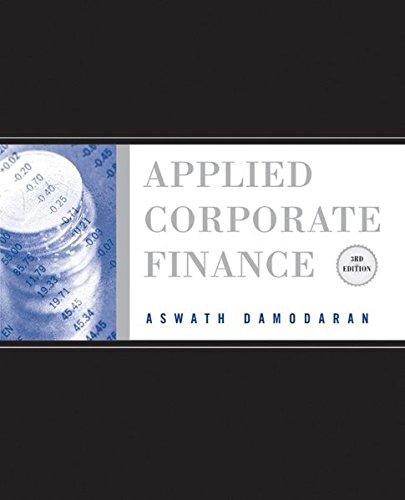Objective To examine a firms current financing choices and to categorize them into debt (borrowings) and equity
Question:
Objective To examine a firm’s current financing choices and to categorize them into debt
(borrowings) and equity and to examine the trade-off between debt and equity for your firm.
Key Questions
• Where and how does the firm get its current financing?
• Would these financing choices be classified as debt, equity, or hybrid securities?
• How large, in qualitative or quantitative terms, are the advantages to this company from using debt?
• How large, in qualitative or quantitative terms, are the disadvantages to this company from using debt?
• From the qualitative trade-off, does this firm look like it has too much or too little debt?
Framework for Analysis
• Assessing Current Financing 1.1. How does the firm raise equity?
a. If it is a publicly traded firm, it can raise equity from common stock and warrants or options.
b. If is a private firm, the equity can come from personal savings and venture capital.
1.2. How (if at all) does the firm borrow money?
a. Does it use bank loans or corporate bonds?
b. What is the maturity structure for the debt?
c. What type of debt does the firm have? (Currency mix, fixed versus floating)
1.3. Does the firm use any hybrid approaches to raising financing that combine some of the features of debt and some of equity?
• Examples would include preferred stock, convertible bonds, and bonds with warrants attached to them.
2. Detailed Description of Current Financing 2.1. If the firm raises equity from warrants or convertibles, what are the characteristics of the options (exercise price, maturity, etc.)?
2.2. If the firm has borrowed money, what are the characteristics of the debt (maturity, coupon or stated interest rate, call features, fixed or floating rate, secured or unsecured, and currency)?
2.3. If the firm has hybrid securities, what are the features of the hybrid securities?
3. Breakdown into Debt and Equity 3.1. If the firm has financing with debt and equity components (such as convertible bonds), how much of the value can be attributed to debt and how much to equity?
3.2. Given the coupon or stated interest rate and maturity of the nontraded debt, what is the current estimated market value of the debt?
3.3 What is the market value of equity that the firm has outstanding?
4. Trade-Off on Debt versus Equity Benefits of Debt • What marginal tax rate does this firm face, and how does this measure up to the marginal tax rates of other firms? Are there other tax deductions that this company has (like depreciation) to reduce the tax bite?
• Does this company have high free cash flows (for example, EBITDA/firm value)? Has it taken and does it continue to have good investment projects?
How responsive are managers to stockholders? (Will there be an advantage to using debt in this firm as a way of keeping managers in line or do other [cheaper] mechanisms exist?)
Costs of Debt • How high are the current cash flows of the firm (to service the debt) and how stable are these cash flows? (Look at the variability in the operating income over time.)
• How easy is it for bondholders to observe what equity investors are doing?
Are the assets tangible or intangible? If not, what are the costs in terms of monitoring stockholders or in terms of bond covenants?
• How well can this firm forecast its future investment opportunities and needs?
The information about current financing choices can almost all be extracted from the financial statements. The balance sheet should provide a summary of the book values of the various financing choices made by the firm, though hybrids are usually categorized into debt (if they are debt hybrids) and equity (if they are equity hybrids). The description of warrants outstanding as well as the details of the borrowing that the firm has should be available in the footnotes to the balance sheets. In particular, the maturity dates for different components of borrowing, the coupon rates and information on any other special features should be available in the notes.
Online sources of information: Review www.stern.nyu.edu/~adamodar/cfin2E/project/data.htm.
Step by Step Answer:






